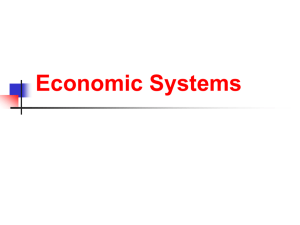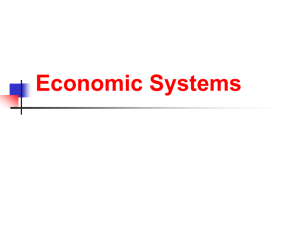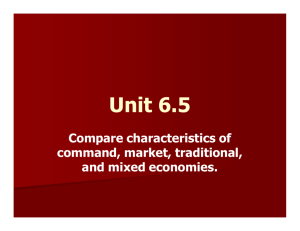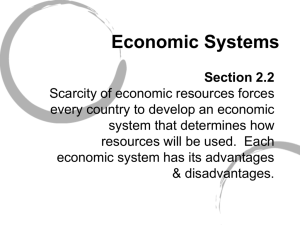The 3 Key Economic Questions every Society must
advertisement
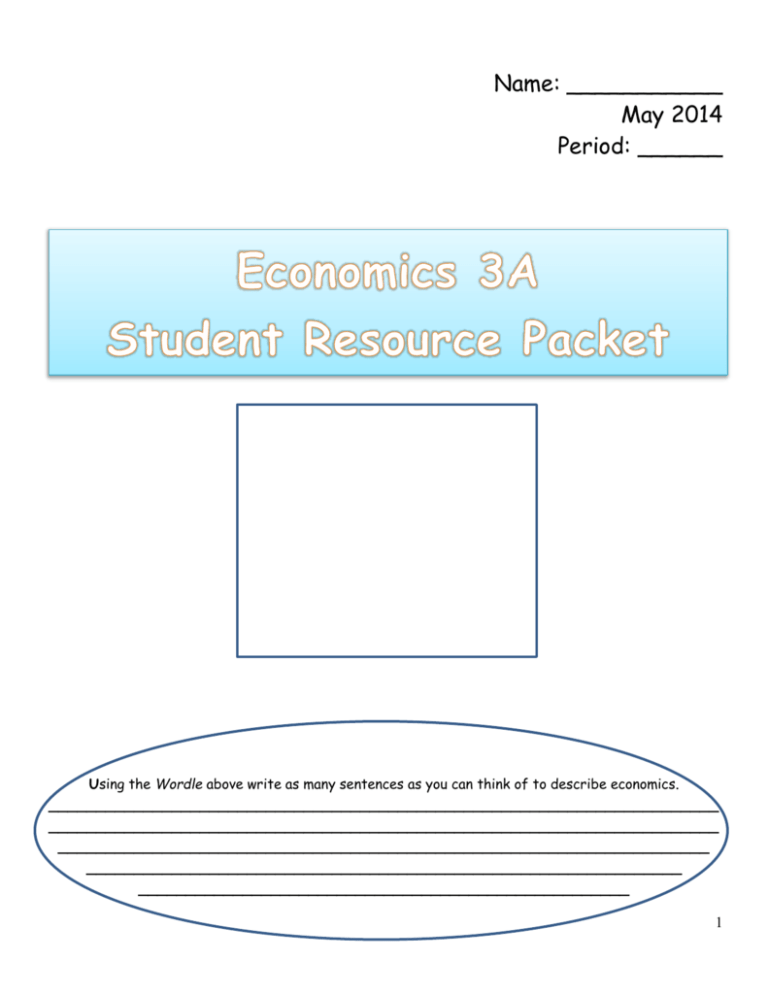
Name: ___________ May 2014 Period: ______ Using the Wordle above write as many sentences as you can think of to describe economics. _______________________________________________________________________ _______________________________________________________________________ _____________________________________________________________________ _______________________________________________________________ ____________________________________________________ 1 The 3 Key Economic Questions every Society must answer: As we have been learning, everyone is forced to deal with scarcity. We, as individuals, are forced to deal with it. We, as families, are forced to deal with it. And we, as societies, as countries, are forced to deal with it. The way we, as individuals, face it is through the choices we make. Since all of us make different individual choices, it stands to reason that we all use different methods, or reasoning, to arrive at those choices. Different societies & countries also use different methods to arrive at their choices. Because of scarcity (not enough to go around because of LIMITED resources), every nation is faced with “The 3 Key Economic Questions Every Society Must Ask:… ● What –goods & services should be produced? “What to produce?” is an allocation question. All economic systems must determine how to allocate productive resources in the form of land (natural resources/raw materials), labor (work for which we earn pay) and capital (human - education & job training) (physical – buildings, equipment & tools). ● Who – consumes the goods & services produced in society? “For whom?” is a public choice question. All economic systems must determine which goods and services will be available for public use and which for private use. ● How – should goods & services be produced? “How to produce?” is an efficiency (the ability to do something or produce something without wasting materials, time, or energy ) question. All economic systems must determine how goods and services will be produced. In Column 1 list the three questions that each society must answer. In column 2 explain the question that must be answered. Column #1 Column #2 123- 2 Define scarcity: Define efficiency: To know how different countries respond to the 3 Key Economic questions we first need to define economics. Economics is the science that deals with the ways in which goods and services are produced transported, sold, and used in a country. How a country determines this is based on available resources and their cultural values. Countries must decide how they are going to use their limited resources to produce the unlimited wants of their citizens. This is known as the allocation (setting aside for a specific purpose) of limited resources in order to satisfy unlimited wants and needs. Define the word allocate: ______________________________________________________________ What do societies need to allocate and WHY do they have to allocate? ________________ _____________________________________________________________________ _____________________________________________________________________ _____________________________________________________________________ An economic system is primarily characterized by the way the country, or society, answers the basic three economic questions: What to produce, Who gets it and How will it be produced?. Two real-world economic systems that differ greatly are capitalism and communism. Capitalism can be described as a Market Economy. Capitalism is an economic system in which ownership and control is largely in private hands (businesses and households), as opposed to public hands (government)-like it is in communism. One of the key concepts that capitalism values is private property rights. Communism, in contrast, is an economic system in which ownership and control predominately rests with government. Socialism is a third noted economic system that borrows institutions from both capitalism and communism. What type of economy is capitalism? ________________________________________ What type of economy is communism? _______________________________________ Who has control of production in a… Market Economy? _____________________________________________________ Command Economy? ____________________________________________________ 3 Bead Game Debriefing Read each statement to the left and place a check under the corresponding type of economic system. Traditional Command Market The government told us what to make. Individuals chose their jobs. Customs dictated jobs. Produced for the highest bidder. Government decides what is needed. Most stressful. Competition! Motivated through social gain. Least stressful. Culture directed jobs. Produced for those who were declared in need. 4 Types of Economic Systems There are different types of economic systems that answer the three questions differently and they can be categorized according to who makes most of the decisions in the economy. Most economies can generally be categorized as one of three kinds: A traditional economy is defined by three characteristics: 1) It is based on agriculture, fishing, hunting, gathering or some combination of the above. 2) It is guided by traditions. 3) It may barter goods/services instead of using money as a means of exchange. This type of economy relies on traditions and customs to determine what is produced and how it is produced. Individuals are not worried about making a profit and therefore, do not invest in the latest technology. They do what they’ve always done. For these reasons, people who live in a traditional economy appear to be living in poverty, even if their daily needs are being met. Most traditional economies operate in emerging markets (coming into existence; just beginning), or Third World countries. They are usually located in Africa, Asia, Latin America and the Middle East. However, pockets of traditional economies can be found throughout the world. Examples we have studied include Togo, Africa and Mongolia. In the box below create your own WORDLE to describe a Traditional Economy. 5 A command economy is where economic decisions are planned out in detail by the central government authority. The plan is implemented (carried out) through laws, regulations and directives. Businesses follow production and hiring commands instead of individually and freely responding to the laws of supply and demand. Central planners seek to replace the forces that operate in a free market economy, and the customs that guide a traditional economy, to attain specific societal goals. In theory, communism is an economic system based on: (1) a classless society, (2) common ownership of resources, (3) government ownership, and (4) income distributed according to needs. As practiced in the real world, communism is an economic system based on (1) government ownership--government ownership and control of most resources and the means of production and (2) central planning--excruciatingly detailed and comprehensive resource allocation decision making by the central government. Under real world communism, governments undertake the vast majority of the resource allocation decisions, with few decisions undertaken by individuals. The former Soviet Union was the primary example of real world communism before if disbanded in the late 1980s. China, Cuba, and a scattering of African nations continue to operate under various forms of communism. Characteristics of a Command Economy A modern centrally planned economy can be identified by the following five characteristics: 1. The government creates a central economic plan for all sectors and regions of the country. The goals are to generate (create) economic growth, increase production efficiency and best utilize scarce resources. For the most part, a command economy needs a political system that is also centrally planned. 2. The government allocates all resources according to the central plan. The goal is to use the nation's capital, labor and natural resources in the most effective way possible. 3. The central plan sets the priorities for production of all goods and services. The goal is to supply enough food, housing and other basics to meet the needs of everyone in the country. In addition, it may have other priorities, such as mobilizing for war or increasing the nation's economic growth. 4. The government owns a monopoly (only one owner) business in industries deemed (considered) important to the goals of the economy. This usually includes finance, utilities, and automotive. There is no competition in these industries. 6 5. The government creates the laws that regulate economic activity. These include regulations, directives and wage/price controls to implement the central plan. Examples include the former Soviet Union and current Cuba. In the box to the left, create a WORDLE to describe a Command Economy. Write 10 word summaries for each of the five (5) characteristics of a Command Economy. Be prepared to share! Capitalism is undoubtedly at the top of any list of economic systems operating in the modern world. This system is based on: (1) private property--private ownership of resources and the means of production, (2) individual liberty--relative freedom on the part of the resource owners to use their resources as they see fit, and (3) competitive markets--a system of relatively competitive markets. Under capitalism, governments establish the basic rules of the game but the vast majority of resource allocation decisions are undertaken (made) by individuals, as either consumers or producers. The United States is one of the more noted examples of capitalism. However, most modern industrialized economies of Europe, Asia, North America, and South Resources that can be used to bring in a large profit are allocated for that good or service that brings in the profit. America operate under capitalism. A market economy is an economic system in which prices are based on competition among private businesses and not controlled by a government. It relies on prices to allocate goods, services, and productive resources. That means that production of goods and services are determined by the laws of supply and demand. Producers 7 sell their goods and services at the highest possible price that consumers are willing and able to pay. Workers also try to get the most pay for their skills. Characteristics of a Market Economy 1) Private Property-Most goods and services are privately owned. This allows business owners to buy, sell, lease or rent their property. Private property gives them the right to profit from ownership. 2) Freedom of Choice- Owners, businesses, consumers and workers are free to produce, sell and purchase goods and services in a free market. The only thing that may stop them is the price they are willing to pay for or sell the item and the amount of capital (money) they may have. 3) Competition- Competition for goods and services brings prices down and ensures that they are provided efficiently. When demand increases prices goes up. When producers see that demand is higher they will begin producing more- this will add to the supply. An increase in supply will lower the price and only the best producers will be able to continue producing. This applies to jobs as well as consumers. 4) Limited Government- the role of government is to ensure that the markets are open and working. The government watches to make sure no one is unfairly manipulating those markets and that all information is distributed evenly. The term laissez-faire (meaning keep the government out of the economy) was coined by Adam Smith a famous economist. Examples include the United States and Great Britain. Create a WORDLE to describe a Market Economy in the box below. 8 So, how do different economic systems respond to the three basic economic questions? In a market economy, most of the decisions in the economy about what to produce, how to produce it and who receives it are made by ___________ and firms. In a command economy, __________ officials make most of the decisions in the economy about what to produce, how to produce it and who receives it. In a traditional economy the decisions are made according to ______________ & __________. A Mixed System incorporates elements of both command and market systems in determining answers to the three questions. Mixed economies with strong market components also include a public goods and services sector, just as command economies like Cuba include a private goods and services sector. Traditional Traditional: Market How does each economy answer the three questions? Market: Command Command: 9 Political Cartoons What type of economic system is being described in the cartoon above? _________________ How do you know? _________________________________________________________ _______________________________________________________________________ _______________________________________________________________________ How is this cartoon showing the differences between a Command Economy (Communism) and a Market Economy (Capitalism)? ____________________________________ ____________________________________ ____________________________________ ____________________________________ ____________________________________ ____________________________________ ____________________________________ ____________________________________ ____________________________________ ____________________________________ ____________________________________ 10 Advantages and Disadvantages of the Three Most Common Economies in the World Directions: Read the information below and complete the chart on the next pages. In the world of today there are three major types of economies. Traditional economies are dictated by tradition, customs, and, to a large extent, religion. As time goes on this type of economy is becoming more and more scarce. Command economies, such as the former Soviet Union, North Korea, and Cuba, have a central government that controls just about everything in the society. The third and final major economy is the market economy. This is a mostly free economy, where the central government is weak and the businesses do as they please to make a profit. Each of these economies has many positive and negative aspects. Traditional Economy One of the few advantages existing in a traditional economy is that the roles of individuals are clearly defined. Every member of the society knows exactly what they are to do and most don’t have any complaints about it. There are also many disadvantages to this type of society. These societies are often very slow to change and when new technologies are introduced, these ideas and techniques are discouraged. Command Economy Command economies have many advantages to it. One advantage is that equality is focused on. The government tries to eliminate all private property and distribute its good equally. If done correctly no one is in poverty and no one is wealthier than another. Social services are also emphasized in this type of economy. The government will provide equal health care, education opportunities, and make sure all people are fed. A third advantage to this type of economy is that it is capable of rapid change for major problems. The government owns the companies, so if production needs need to be shifted into a different area, the government is capable of doing it rather quickly. A final major advantage of command economies is that they are very stable. Command economies will never have sudden depressions. Although command economies may seem like a utopian form of economics, they also have many disadvantages. In command economies there is very little freedom. The individual usually doesn’t have the opportunity to decide what they want to do for a career, and they have no control over the goods they receive. Another major problem is that there is little reason for innovations, hard work, or quality of the work. Since no one makes more money than everyone else, the people feel like there is no reason to work hard. A third disadvantage is that there is little focus on consumer wants. Finally, when it comes to minor day-to-day changes, the government has a hard time coping with them. 11 Market Economies In recent years, market economies have become more and more popular. Three major examples of market economies are The United States, Japan, and France. One major advantage is that market economies can adjust to change easily. If there is a demand for one thing, companies have the ability to change what they produce instead of having to go through too much government protocol first. Rational self interest in market economies are also encouraged. People have the ability to make as much money as they can and do what is in their best interest. Another positive to market economies is that the government tries to stay out of the way of businesses. Although the government sets certain standards businesses must follow, for the most part businesses can do as they please, allowing them to produce what they want, how they want. A fourth advantage to the market economy is that there is a great variety of goods and services for consumers. If there is a demand for a good or service, the demand will almost always be met in a market economy. Although there are a lot of positives to market economies, there are also many negatives that go along with it too. One major problem with this type of economy is that it doesn’t always provide the basic needs to everyone in the society. The weak, sick, disabled, and old sometimes have trouble providing for themselves and often slip into poverty. Another problem is that it becomes hard for a government with so many private businesses to provide adequate defense, education, and health care to its people. A third disadvantage to this type of economy is that there is uncertainty in the business world. One company could easily be forced out of business causing all of its employees to become unemployed and lose their means of income. The final major disadvantage is that occasionally there are market failures. This can cause some companies to become way to powerful and become a monopoly. If the government doesn’t step in, the monopoly can take advantage of the consumers and charge ridiculously high prices. Conclusion Each of these types of economies has its own unique positives and negatives. It may seem like one economic system is better than another, but it all depends on what the viewer deems important. 12 Advantages and Disadvantages of the Three Most Common Economies in the World Economic System Advantages Disadvantages Traditional Command Market Think.Pair.Share. Which economic system do you feel is the best? Explain your answer. _______________________________________________________________________ _______________________________________________________________________ _______________________________________________________________________ _______________________________________________________________________ _______________________________________________________________________ _______________________________________________________________________ _______________________________________________________________________ _______________________________________________________________________ _______________________________________________________________________ _______________________________________________________________________ 13

